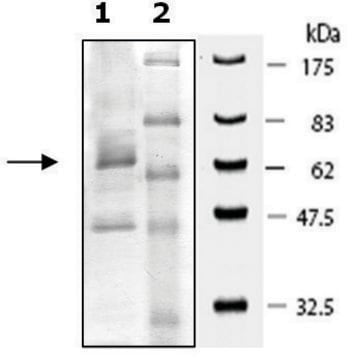L5751
L-Lysine dihydrochloride
≥98% (HPLC), suitable for ligand binding assays
Synonym(s):
(S)-2,6-Diaminohexanoic acid dihydrochloride
Select a Size
About This Item
Recommended Products
Product Name
L-Lysine dihydrochloride, ≥98% (HPLC)
Quality Level
Assay
≥98% (HPLC)
form
powder
technique(s)
ligand binding assay: suitable
color
white to faint yellow
mp
200-206 °C (lit.)
SMILES string
Cl[H].Cl[H].NCCCC[C@H](N)C(O)=O
InChI
1S/C6H14N2O2.2ClH/c7-4-2-1-3-5(8)6(9)10;;/h5H,1-4,7-8H2,(H,9,10);2*1H/t5-;;/m0../s1
InChI key
JBBURJFZIMRPCZ-XRIGFGBMSA-N
Looking for similar products? Visit Product Comparison Guide
1 of 4
This Item | SRP0437 | SRP0258 | SRP0436 |
|---|---|---|---|
| assay ≥70% (SDS-PAGE) | assay ≥30% (SDS-PAGE) | assay ≥70% (SDS-PAGE) | assay ≥30% (SDS-PAGE) |
| biological source rat | biological source rat | biological source human | biological source rat |
| recombinant expressed in baculovirus infected Sf9 cells | recombinant expressed in baculovirus infected Sf9 cells | recombinant expressed in baculovirus infected insect cells | recombinant expressed in baculovirus infected Sf9 cells |
| form aqueous solution | form aqueous solution | form aqueous solution | form aqueous solution |
| UniProt accession no. | UniProt accession no. | UniProt accession no. | UniProt accession no. |
Biochem/physiol Actions
Storage Class Code
11 - Combustible Solids
WGK
WGK 3
Flash Point(F)
Not applicable
Flash Point(C)
Not applicable
Personal Protective Equipment
Choose from one of the most recent versions:
Certificates of Analysis (COA)
Don't see the Right Version?
If you require a particular version, you can look up a specific certificate by the Lot or Batch number.
Already Own This Product?
Find documentation for the products that you have recently purchased in the Document Library.
Customers Also Viewed
Our team of scientists has experience in all areas of research including Life Science, Material Science, Chemical Synthesis, Chromatography, Analytical and many others.
Contact Technical Service










